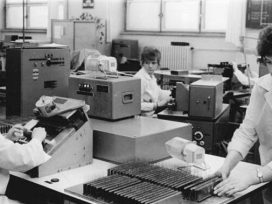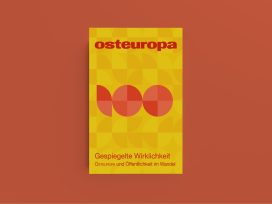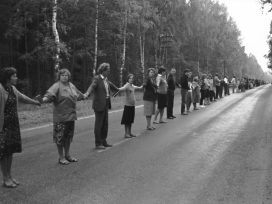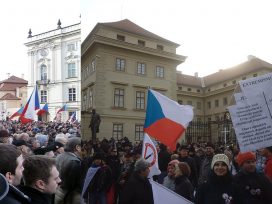 Georges Canguilhem, the French epistemologist of life sciences, traced how the master binary “normal-pathological” helped introduce biopolitics into the existence of bodies and populations. Those who define what is normal and what is deviant, thought Canguilhem, have the power to classify people and to create new kinds of subjects. This idea, famously developed by Michel Foucault, has since been appropriated by academics working in various contexts, including that of post-socialism in the early 1990s. Here, totalitarianism was represented as a social pathology using telling metaphors such as “virus” and “cancer”, while democratization and the establishment of a liberal state and society was seen as the recovery of a degree of social normality many felt themselves entitled to. Put differently, people strove “to return to civilization”, to “come back to Europe”. The juxtaposition of “the recent past”, as something that was “abnormal”, and “the near future”, as something that was “normal”, was very popular in the discourse on normality in eastern Europe and Russia, which achieved some notoriety in its day. Accustomed to situating their lives and experiences in relation to master narratives of progress and innovation, many simply replaced what was commonly called a “communist future” with a capitalist one.
Georges Canguilhem, the French epistemologist of life sciences, traced how the master binary “normal-pathological” helped introduce biopolitics into the existence of bodies and populations. Those who define what is normal and what is deviant, thought Canguilhem, have the power to classify people and to create new kinds of subjects. This idea, famously developed by Michel Foucault, has since been appropriated by academics working in various contexts, including that of post-socialism in the early 1990s. Here, totalitarianism was represented as a social pathology using telling metaphors such as “virus” and “cancer”, while democratization and the establishment of a liberal state and society was seen as the recovery of a degree of social normality many felt themselves entitled to. Put differently, people strove “to return to civilization”, to “come back to Europe”. The juxtaposition of “the recent past”, as something that was “abnormal”, and “the near future”, as something that was “normal”, was very popular in the discourse on normality in eastern Europe and Russia, which achieved some notoriety in its day. Accustomed to situating their lives and experiences in relation to master narratives of progress and innovation, many simply replaced what was commonly called a “communist future” with a capitalist one.
At the same time, thinking about normality in the way elaborated by Canguilhem allows a detached perspective on the complex configuration of temporalities in which we find ourselves. Too often, when I describe something as specific to either socialist or post-socialist experience, I ask myself: Could it be that it has
always been this way? Layers of time get embodied in things, in the walls of new buildings, in the patches of fresh paint applied to derelict Khrushchev-era apartment blocks. Lived time and lived space need to be passed through. Yet today, layers of language, of discourse, texts that were previously unavailable, that lack a definite context, are half-digested and hence produce inchoate psychic impulses; it is too often that an intellectual turns into a decentred nexus of influences. Should the discourse we use to reflect on post-Soviet experience be post-Soviet, non-Soviet, or something else? This dilemma is rather like the contrast between grocery shopping then and now: then, the queues were long for the bare necessities (soap, salt, flour, cooking oil, etc.). Now, the shelves are crowded with delicacies from abroad. Then, one had to collect endless signatures to gain access to a secret room in the local library (labelled “special storage”) where, like prisoners, the works of Nietzsche, Berdyaev, Freud, and Jung, were confined. Now, one is stunned by the nearly simultaneous arrival and availability of enigmatic Derrida, ironic Rorty, elegant Nancy, and engaging Sloterdijk. What books to choose and what words to use to dress up reflections on old and new? Which story to follow?
The sense of detachment from the immediate present I find so appealing in Canguilhem comes from his reluctance to reflect on specific subjects manufactured by a particular period of history or a certain political regime. He conceived of “normality” as a relational phenomenon, and usefully emphasized that not all parameters of our existence remain in our power:
Taken separately, the living being and its environment are not normal: it is their relationship that makes them such. For any given form of life, the environment is normal to the extent that it allows its fertility and a corresponding variety of forms such that, should changes in the environment occur, life will be able to find the solution for adaptation – which it has been brutally forced to resolve – in one of these forms.
This statement, I think, prompts one to revisit the conventional time-space coordinates of the last twenty or so years. There is a sense in which linear “transitional” narratives, which operate in terms of closed social systems (East/West), can no longer capture the complexity and continuity of the experience of “then” and “now”. I wish to reflect on the limitations of a sequential narrative of transition “performatively” by demonstrating different ways of applying Canguilhem’s “law” to the socialist/post-socialist experience. I will recall a few versions of this narrative and try to show that at least one attribute of post-Soviet “normality” has always existed, inalienably and persistently, namely: normality as materiality – that is, the chance to establish oneself as an owner and maker of things; as someone who does things with things, to paraphrase the title of John Austin’s book.
If one wants to follow a conventional narrative and persist in thinking about the last two decades’ changes in terms of closed social systems, then one might say that before the post-socialist transformations, the only imaginable changes in the environment that might have led to normality were those obtainable by means of emigration. For instance, someone who left the Soviet Union immediately after the beginning of perestroika says enthusiastically in an Internet forum:
Hurrah to perestroika! It gave me opportunity to leave, to see a half of the world, to settle down with all the attributes of normal life and not to be afraid that someone will scratch a three-letter word on your car or shoot you down in the lobby. Most importantly, there is a future for our children here, they can study and become independent without needing to worry that when they reach eighteen they will have to join the army or live in lawless conditions.
People at first “brutally forced” – to use Canguilhem’s phrase – to adjust to rapidly changing local realities now seem to have found various “solutions for adaptation”. Another person says:
To my name I used to have an apartment in a suburban high-rise estate, a radio […] and a hatred of communism. It was the perfect baggage with which to keep riding the trams on the way to the school where one taught […]. When the system collapsed, I had 200 dollars. It turned out that being smart is enough to orientate oneself in the new circumstances. I got a new education abroad, began to earn per hour the money I used to receive per year and exchanged a tram for a jeep.
Often in the last two decades, whether in academic settings or over an informal dinner, I have found myself reciting my own version of this oh-so-familiar story, in which scholarly generalizations are neatly intertwined with anecdotes and poignant details. It goes like this: it was thought that a “normal”, “natural”, and “healthy” economic, educational, political, and social life was impossible amidst the hostile ideological environment of socialism. An economy based on the allocation of poor-quality goods was unable to meet vital human needs. A heavy dose of ideology was supposed to compensate for a lack of meat to feed one’s offspring: “Hungry? Get your shopping bag closer to a radio!” people used to say. Yet somehow they managed to feed their families by waiting in line for hours, by developing connections with distributors, by becoming highly-qualified and earning enough to be able to buy things at the farmer’s market, or by relying on what later came to be called subsistence farming.
Almost everyone’s family story fits into this description. Our family’s, too. My father, an engineer at the titanium-manufacturing plant, had an additional strategy: he was a good hunter. For years, the elk that he would bring from the local woods was our only stable source of protein. For him and for many others, hunting and growing vegetables, sewing and knitting for sale, or repairing cars and TV sets, were activities that not only bolstered family economies but allowed a feeling independence, self-reliance, and ownership. These activities were unimaginable without the things one owned. A car, a hut in the woods, a hunting rifle, a plot of land with a dacha on it, an apartment, a golden broche to impress clients, a Singer sewing machine inherited from one’s grandmother, a tape recorder, a set of good tools – all these had the quality of real things amidst the simulacra of goods and ideas. They gave people an existential anchor by embodying a sense of history, dwelling, and possessing. “I am the one who owns a thing or two, which means that it’s not for nothing that I live” – this kind of self-understanding was always at work, even in the most depressed of times.
Places one lived and the things one used or cherished were objects of enjoyment and pride. One’s very own house or flat promised a site of control in which it was possible to discern the traces of one’s family history, preferences, and tastes. One’s plot of land with one’s very own apple tree and bed of strawberries worked as a vehicle of individualization much more successfully than volumes written on liberalism. Surely, in the twentieth century, the growing importance of one’s private life as opposed to an alienated social existence was something that united the worlds across the Berlin wall? Walter Benjamin writes about the shell-like quality of a dwelling and thought about “the domestic interior as a whole in terms of an environment in which the individual himself might be contained”. It is easy to imagine a worker whose whole existence was thought to belong to an industrial giant (to the extent that the apartment buildings were often located close to the plant), for whom a favourite chair and a hockey game provided relief from the targets of a five-year plan. Or a university teacher for whom a study with long shelves of books was the best refuge from the suffocating strictures of vulgarized Marxism. But I am reluctant to think that forests, dachas, and homes were merely sites of refugee from the social world. Materialism has indeed prevailed in many strata of society, as a preferred lifestyle or even as an existential orientation. But did it ever really lose its importance?
“Wait a minute,” I say to myself. “You’re no longer telling the familiar story of socialist deprivation and humiliation culminating in post-socialist survival and, finally, normal life. You’re telling the story of ‘adapting’ in Canguilhem’s sense, according to which every human being is periodically prompted to resolve the conflict between herself and her environment.” Here arises the difficult but very interesting conceptual task of deciding on which side of a dynamic relationship, between the environment and the person, to place the real things one owns.
The modern self, argues American philosopher Amelie Rorty, is essentially defined by its property. The basis of the story of one’s life and self-fulfilment is one’s individual capacity to accumulate goods. Thus, one’s personal capital is comprised of one’s skills and talents and one’s property. One can cleverly invest this or let it slip from one’s hands, but the grammar of selfhood is based on the possessive adjective. Property and the means of gaining it comprise the focus of a person’s rights; a forceful alienation of one’s property jeopardizes a person’s integrity.
The integrity of many people was at stake during the period of collectivization and deportation of kulaks. It was at stake when neighbours informed on their neighbours in order to get their hands on their apartments, and when “accommodators” and “thing-lovers” were subjected to periodic exposure by cynically designed anti-petit-bourgeois propaganda. One should add to this the decades of “chronic” deficit of nearly everything, starting with a place in a garage cooperative and a car and ending with a decent bra. I am not sure if this provides a sufficient explanation of the fact that both men quoted above mention their car as an emblem of normality: one is happy that his vehicle is now safe from being barbarically scratched; the other describes his path towards the new era as a jump from the tram to his own jeep. One’s ownership of oneself and of a life story seems to be intricately intertwined with the stories of things that one has owned, that one has lost, that one has dreamed about all one’s life and that one has eventually been able to buy, or still is dreaming of buying, and so on. Here are a few examples. One of Ludmila Ulitskaya’s [contemporary Russian novelist – ed.] heroines mourned her mother’s departure by wearing her mother’s dress till holes appeared in it. Then she shreds it and stuffs her cushions with it so she can sleep and smell her mother’s unforgettable scent. Isn’t this a very unusual version of the “circulation of a matter”? The life story of my brother-in-law (who is now in his early fifties) is structured around a two-story house that his grandfather once owned, that was appropriated by the Bolsheviks, turned into a House of Pioneers and now occupied by an obscure political party. Does he regret not being the owner of this pretty house? He certainly does, but even as a “lost inheritance”, as a sad reminder that things could have been otherwise, this house does matter a great deal, not only linking my relative’s story to those of his well-to-do predecessors, but providing a source of inspiration: all modest items that my relatives own have been endlessly and lovingly improved, be it a flowerbed, a barbeque at their dacha, or their thirty-five square metre apartment.
The real things, the ones imagined and dreamed of, the ones possessed by others and the precious few one was lucky enough to inherit or to obtain, comprise a material environment that binds society together perhaps more efficiently than conventional social bonds. Moreover, in these globalized times, it seems nobody understands any longer what “society” means; it is not by chance that the distinction “socialist – post-socialist society” has lost its analytical edge. How much longer, indeed, will dwell on it?
Speaking of the material environment, it is worth noting the recent “turn to materiality” and “the rise of the new materialisms” – tendencies in social theory that express a certain fatigue with post-structuralism’s emphasis on text and discourse. It has been observed that:
Various new approaches in the anthropology and geography of material culture, in science and technology studies, and in the new sociologies of consumption and risk culture, have pointed towards an understanding of the performative and integrative capacity of “things” to help make what we call society.
Things not only hold a person together, but also society. Could it be that our troubled relationship with property and things in the past simply serves as additional proof of this idea? One’s efforts to get what one wanted, one’s care about what one had, one’s family stories about one’s grandparents’ luck and resourcefulness, one’s own amateurish entrepreneurship – could all this have prepared people for change and ensured the continuity of their experiences? The things people owned and came to own kept their life stories together. For one, people were able to buy the state apartments in which they lived, although their quality remains in many cases truly questionable. In the 1990s, millions became homeowners simply by signing a few papers. The fact that I own my place, by the way, always makes me feeling slightly embarrassed when friends from Vienna or Berlin tell me of their relationships with landlords and constantly rising rents. Do I really expect to find in them grateful listeners to stories about my former “material” dreams? By virtue of their location on the left of the political spectrum (whatever that means these days), they are more interested in hearing about the reasons for many Russian intellectuals’ unwillingness to become politically active.
Well, we are not really passive. Over the last two decades, what people wanted out of life – what they needed in order for their lives to be “normal” – varied dramatically. In the early 1990s, many hoped (and invested much emotion in these hopes) that their countries would achieve what might be called social-political normality (which for many meant above all shelves stacked with goods). When the rise of corruption and authoritarianism led to the shrinking of the public realm, the trope of normality found a different locus: everyday life, where, I believe, it still resides.
Over the last two decades, the revolutionary energy of the populations of the big cities of Russia and eastern Europe was thwarted. Today, pragmatic urbanites are politically disenchanted. Busily pursuing individual interests, they recall their romantic expectations and democratic aspirations of the late 1980s with slight irony. City squares, the former meeting places of the perestroika years, are now deserted or converted into parking lots (like in my city), while more and more shopping malls appear. The idea of “democracy” has been adopted by nearly every political party and in the process become so compromised that, though it continues to be used in public discourse, it has ceased to be a positive ideal (as that which is “normal”). Jacques Rancière has argued that democracy is only “democracy” if sanctioned by a government. Explaining the current troubles with democracy that are experienced everywhere, Rancière notes that the anti-democratic discourse ubiquitous today represents democracy as something that “comprises traits that until quite recently were attributed to totalitarianism”. The ambivalent outcome of the politics of eastern European countries and Russia over the last two decades has been their inadvertent contribution to what seems to be a widespread disappointment in democracy. Many Russians oscillate between their wish to be citizens of a truly democratic country and to have their say on important local and national matters, and their everyday apolitical concerns (many of which are material). But I doubt that this dilemma is unique to Russia.
Before post-socialism it was not the life of the individual but the life and wellbeing of “collectives”, or “society” that worked as an ideological means for mobilizing populations. However, human life continues to be used as a resource, continues to be mobilized, continues to function as a fuel for the economy and a material for politics. To give just one example: the Russian state, by paying large subsidies to those who wish to have a second child, hopes to fulfil its ambitions regarding the Siberian and Far Eastern territories, which, supposedly, need to be re-populated. Speaking of populating territories, I recently showed my students Helene Chatelain’s documentary on the Gulag. I was amazed by some of the reactions I received. Some of my students said they were “mesmerized” by the grandeur of the scenes of “people conquering nature”. How about the fact, I asked, that it was -50°, that the “conquerors” were barefoot, and that many of them died? Sure, their reply was, but still, wasn’t it great that “with their help we managed to develop the new territories?” The seductiveness of grand ideas and grand scale keeps reproducing itself in new generations.
Commenting on Alan Badiou’s provocative statement that the worse Stalinist terror is better than the most liberal capitalist democracy, Slavoj Zizek claims that opening up “space” was one of Stalinism’s accomplishments and asks: “Can one imagine a utopian point at which this subterranean level of the utopian Other Space would unite with the positive space of ‘normal’ social life?”. It seems that one can. Thinking of themselves as good professionals oriented towards normal lives, these students accept the fact that the life of the anonymous subjects of a great empire, their empire, can be used in service of a higher purpose. They imagine themselves inhabiting gated communities where the chance to meet “undesirable elements” is minimal; but it is equally thrilling for them to think of the vast spaces that have been made “ours” by turning hundreds of thousands or people into “undesirable elements” and putting them to work as slaves.
In today’s discourse, normality has above all come to denote a material standard of living. It is thought normal to own a car and abnormal to travel on a packed bus. I read recently in a magazine that the fear of losing what one has, namely one’s position and the salary that makes possible a certain standard of living, has lead people to engage in risky existential experiments. In order to find out what it is like to have nothing, they buy special services that allow them to play a homeless person or a prostitute on Moscow’s streets. Is this a way to experience the disintegration of one’s personality in the absence of the things one is used to? If so, could it be that a new material environment, made possible by oil bounty (residential skyscrapers, impeccable shopping malls, and suburban villages) has made its way straight into people’s souls? “This is where I want to belong!” a young men tells himself and indeed, it seems there is no dictate of the market, no boss, that he wouldn’t be willing to submit to. He patiently postpones gratification and lives frugally, keeps paying the huge mortgage and interest on consumer credit.
People owning (or striving to own) new and fashionable consumer goods tend to maintain spatial, social, and emotional distances between themselves and those less fortunate. However, even if one has been able to leave behind the crumbling building of one’s former life, one cannot avoid daily encounters with everyday materiality. It imposes itself most annoyingly in the long hours spent in traffic jams, caused by the narrow roads and the over-abundance of cars. Unless, of course, one is a president or a high-ranking official, who takes it for granted that in order to reach their destinations quickly, the rest of the traffic should be paralyzed. While the middle classes limit their exposure to the deteriorating materiality of the past by replacing things they don’t like with new ones, it is by looking at “superfluous” people’s relationships with objects that one gets an acute sense of injustice.
Things get worn out and so do people; for too many today, the allure of acquisition is limited to the basics. One sees immigrants buying chicken skin, pensioners undertaking shopping expeditions to wholesale markets to get the cheapest pasta possible, and one can’t help thinking that a fairer distribution of oil revenues could easily make those people the happy owners of something new that would last for decades. Yet, however tempting it is to talk of fetishism, reification, alienation, and inequality, I think it is too early for normative assessments of what is going on. Tracing what we do with things prompts one to temporarily refrain from judgment and to bear witness to the stubborn materiality of one’s and society’s existence. That is what keeps us grounded.
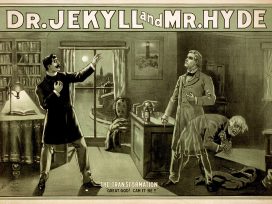
 Georges Canguilhem, the French epistemologist of life sciences, traced how the master binary “normal-pathological” helped introduce biopolitics into the existence of bodies and populations. Those who define what is normal and what is deviant, thought Canguilhem, have the power to classify people and to create new kinds of subjects. This idea, famously developed by Michel Foucault, has since been appropriated by academics working in various contexts, including that of post-socialism in the early 1990s. Here, totalitarianism was represented as a social pathology using telling metaphors such as “virus” and “cancer”, while democratization and the establishment of a liberal state and society was seen as the recovery of a degree of social normality many felt themselves entitled to. Put differently, people strove “to return to civilization”, to “come back to Europe”. The juxtaposition of “the recent past”, as something that was “abnormal”, and “the near future”, as something that was “normal”, was very popular in the discourse on normality in eastern Europe and Russia, which achieved some notoriety in its day. Accustomed to situating their lives and experiences in relation to master narratives of progress and innovation, many simply replaced what was commonly called a “communist future” with a capitalist one.
Georges Canguilhem, the French epistemologist of life sciences, traced how the master binary “normal-pathological” helped introduce biopolitics into the existence of bodies and populations. Those who define what is normal and what is deviant, thought Canguilhem, have the power to classify people and to create new kinds of subjects. This idea, famously developed by Michel Foucault, has since been appropriated by academics working in various contexts, including that of post-socialism in the early 1990s. Here, totalitarianism was represented as a social pathology using telling metaphors such as “virus” and “cancer”, while democratization and the establishment of a liberal state and society was seen as the recovery of a degree of social normality many felt themselves entitled to. Put differently, people strove “to return to civilization”, to “come back to Europe”. The juxtaposition of “the recent past”, as something that was “abnormal”, and “the near future”, as something that was “normal”, was very popular in the discourse on normality in eastern Europe and Russia, which achieved some notoriety in its day. Accustomed to situating their lives and experiences in relation to master narratives of progress and innovation, many simply replaced what was commonly called a “communist future” with a capitalist one.


